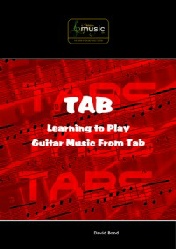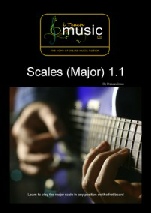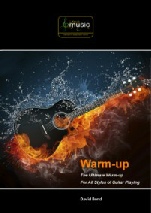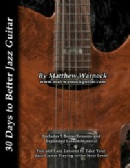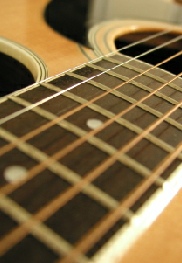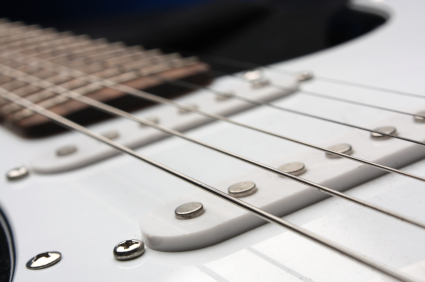



Learn from the best teachers around the world from the comfort of your own home
Featured Teachers
- Bill Hart
- Duncan Jones
- Emrys Baird
- Jim Covington
- Colin Cartmell
- Daniel Realpe
- Simon James
- Pauric Mather
- Niels Vejlyt
- David Bond
- Matt Warnock
- Andrea Basiola
- MDS
- Carlos Viegas
- Matt Pearce

Learn the following styles:
- Rock
- Blues
- Country
- Classical
- Jazz
- Jazz Fusion
- County Rock
- Pop
- Bluegrass
- Slide
- Heavy Metal
- Shred

E-books Available from our shop:
- Deryl Gabel
- David Bond
- Duncan Jones
- Matt Warnock
- Pauric Mather

Blog
We have an extensive range of blog articles from guest writers such as:
Tom Hess
Andrea Basiola
Colin Cartmell






| Terms of Use | Privacy Policy | Teachers Wanted | Downloads | Legal | Returns Policy | Prize Rules|



Internet Guitar Lessons
Professional Lessons
At Affordable Prices




Connect with us:




Guitar Online Metronome

Learning to play in time is an essential skill every musician has to acquire, one tool for that is the use of the metronome. Not only does it allow you to play in even tempos, it also allows you to focus on technique and the building of of speed, slowly and steadily as well as a solid sense of time.
Speak to any musician and almost without exception they would have clocked up many hours of practice with a metronome. Musical timing is as important as note choice, being able to play “in the pocket” takes practice and experience.
Developing Timing
In order to develop a strong rhythmic sense, you need to understand how notes can be played across an underlying pulse and also to develop a rock solid inner sense of time.
Counting out loud, is not the most reliable way of keeping time, a far more efficient method is what's called movement based time keeping. This essentially means moving a part of your body to help you lock in the beat, a common movement is to tap your foot.
In order to develop this habit when ever you practice with your metronome tap you foot along with the beat as you play.
A good exercise is to set the metronome at a slow tempo ( 60 - 90 bpm) and clap you hands to every beat. What you will find is that its actually harder to do than you think as there is a tendency to try and anticipate the beat. One solution is to use a circular hand movement, as a constant motion is easier to keep in time. Try and feel the subdivisions of the beat, for example the bottom of the “beat circle” should be the “and” of an eight note.
By developing an inner sense of time, slower tempos will become easier to play.
Practice makes perfect
Its not the quantity of practice you do, but the quality - 10 minutes of focused practice can be better than 1 hour of playing hoping that the tricky bit is not going to catch you out this time. Try to practice so that the making of music becomes free from stress and worries. The easiest way of messing something up is worrying about messing something up!. If you are relaxed and free from worries music should potentially come out effortlessly. If you practice something 100 times perfectly the chances are that the 101 will also be perfect. However if you practice it with only 50% of the time being perfect , the 101 time will be a but hit and miss at best.
Beyond the wall
We all as players hit walls in our playing, or it can even sometimes me a good idea to try and stretch beyond what you can normally comfortably do. One way of doing this is to set the metronome higher than you can normally play. Even if your playing becomes sloppy you get a peek into what the next level is that your can obtain. Try going no higher than 5% of what you can comfortably play, otherwise can risk eroding the accuracy that you have built up.
Speed Training
In order to develop a speed technique, first the fundamentals must have been mastered to perfection. This allows faster and faster tempos to be attempted with minimum stress. Stick at first to moderate tempos and focus on smooth and evenness of tone. Then gradually work up to level were you start to encounter stress, you can take it back a few notches and then again attempt the higher tempo. With practice the top speed will be elevated and you can then try to go on to a new tempo.
Dynamics can help very important at faster tempos, practice your technique either muted and soft, or loud and un muted. Adding in accents can be a great way of spicing up phrases and they can also help lock in both hands to work together, particularly important for fast alternate picking.
Advanced practice ideas
One good way of strengthen your offbeat timing is to play a constant sixteenth note phase over an eighth note pulse rather than a quarter note. The 3rd sixteenth note will fall on the “and” of the beat.
Missing out beats
Keep the same sixteenth note pulse but instead of playing this over quarter note pulse, try it over a half note pulse - effectively you are playing 32nd notes.
Hemiola
This is a musical device where you can superimpose two different pulses against each other. The easiest place to start is the 3:2 ratio, with this you play a triplet pattern but the click of the metronome will fall on the 3rd note of the pattern, try other ratios such 4:3 pr 5:4.

See instructions at the bottom of the page
Like what you see - check out our teachers for a professional one to one lesson


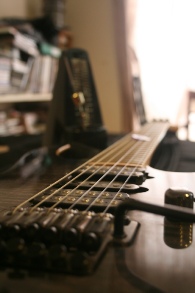
Developing timing takes practice
Metronome Practice ideas
Before even attempting to play a musical ldea or phrase in time with a metronome is to first really listen to it, and try and feel the pulse of music. Try tapping out the rhythms as the music goes, it doesn't matter if you get it wrong its all about trying to feel the timing.
You will find that you will start to instinctively hear what's going on in the music rhythmically and as you become more experienced the process will get easier.
Start slow and gradually build up, always follow the golden rule that if you cant play it slow its going to be a train wreak if you try and play it fast. We will deal with the use of the metronome to develop technique on other pages, here we are focusing on timing.
Play what you can but practice what you cant. That means if you are having problems with a particular series of notes, focus on that, identify what the problem is and practice it until the problems gone and then move on. Don't ignore problem areas by glossing over them rather embrace them and see them as opportunities to improve your playing. Take a section you are struggling with and really slow it down and focus, this type of practice can literally make a problem go way in minutes rather than weeks or months.
Play a phrase and gradually speed up the metronome settings, constantly looking for problem areas in technique and timing.

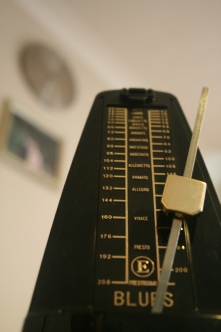
Practice slowly and build up the speed gradually




